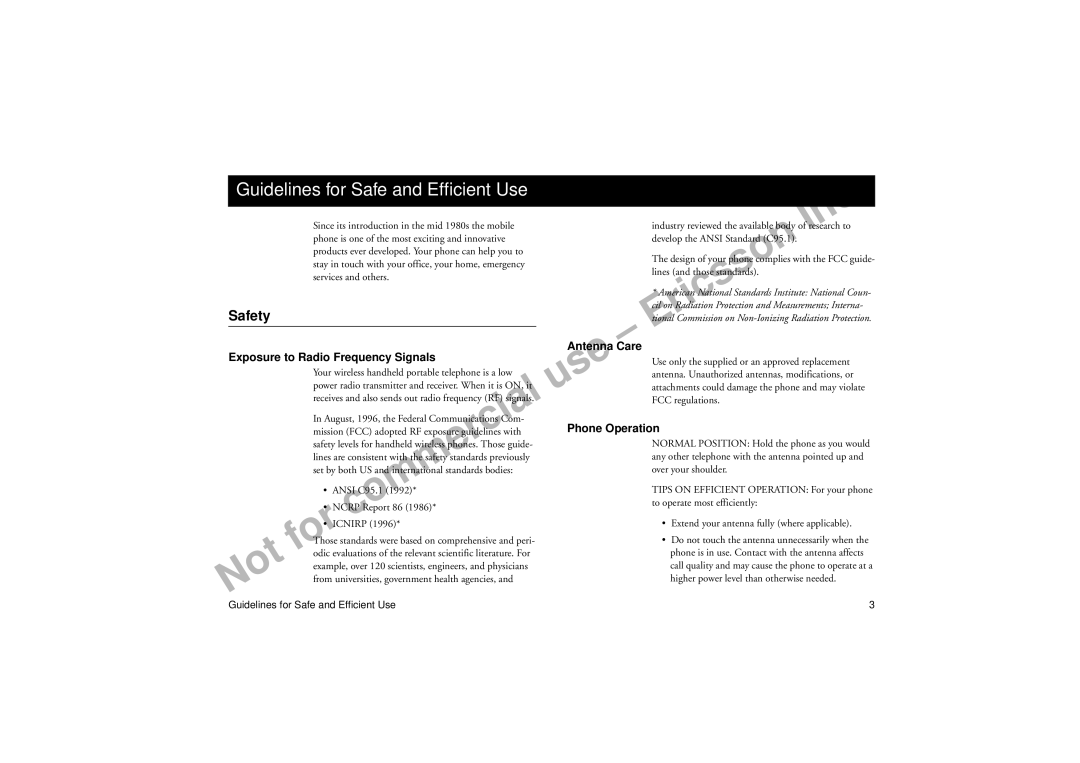| Guidelines for Safe and Efficient Use |
|
| . | |||
|
|
| |||||
|
|
|
|
|
|
| c |
|
|
| Since its introduction in the mid 1980s the mobile |
|
| n | |
|
|
|
| industry reviewed the available bodyIof research to | |||
|
|
| phone is one of the most exciting and innovative |
| develop the ANSI Standard (C95.1). | ||
|
|
| products ever developed. Your phone can help you to |
| The design of your phone complies with the FCC guide- | ||
|
|
| stay in touch with your office, your home, emergency |
| |||
|
|
|
| lines (and those standards). | |||
|
|
| services and others. |
| |||
|
|
|
|
| son | ||
|
|
|
|
|
| s | |
|
|
|
|
|
| * American National Standards Institute: National Coun- | |
|
|
|
|
|
| c |
|
|
|
|
|
|
| cil on Radiation Protection and Measurements; Interna- | |
| Safety |
|
|
|
| ri |
|
|
|
|
|
| tional Commission on | ||
|
|
|
|
| E |
| |
|
|
|
|
|
| ||
|
|
|
|
| – |
|
|
|
|
|
|
| Antenna Care |
|
|
| Exposure to Radio Frequency Signals | e | Use only the supplied or an approved replacement | ||||
|
|
| Your wireless handheld portable telephone is a low | s | antenna. Unauthorized antennas, modifications, or | ||
|
|
| power radio transmitter and receiver. When it is ON, it | u | attachments could damage the phone and may violate | ||
|
|
| receives and also sends out radio frequency (RF) signals.l | FCC regulations. |
| ||
|
|
| In August, 1996, the Federal Communications Com- | Phone Operation |
| ||
|
|
| mission (FCC) adopted RF exposure guidelines with |
| |||
|
|
| safety levels for handheld wireless phones.rciaThose guide- |
| NORMAL POSITION: Hold the phone as you would | ||
|
|
|
| e |
| any other telephone with the antenna pointed up and | |
|
|
| lines are consistent with the safety standards previously |
| |||
|
|
| set by both US and internationalmstandards bodies: |
| over your shoulder. | ||
|
|
| • ANSI C95.1 (1992)* |
| TIPS ON EFFICIENT OPERATION: For your phone | ||
|
|
| • NCRP Report 86 (1986)* |
| to operate most efficiently: | ||
|
|
|
|
|
| ||
|
|
|
| com |
| • Extend your antenna fully (where applicable). | |
|
|
| • ICNIRP (1996)* |
| |||
|
|
| Those standards were based on comprehensive and peri- |
| • Do not touch the antenna unnecessarily when the | ||
|
| or |
|
|
|
| |
| f | odic evaluations of the relevant scientific literature. For |
| phone is in use. Contact with the antenna affects | |||
| ot |
|
| ||||
|
| example, over 120 scientists, engineers, and physicians |
| call quality and may cause the phone to operate at a | |||
|
| from universities, government health agencies, and |
| higher power level than otherwise needed. | |||
N |
|
|
|
|
|
| |
| Guidelines for Safe and Efficient Use |
|
| 3 | |||
Page 6
Image 6
